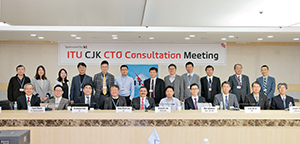 |
|||
|
|
|||
|
Global Standardization Activities Vol. 14, No. 8, pp. 57–59, Aug. 2016. https://doi.org/10.53829/ntr201608gls Trajectory of ITU-T Standardization and Key Issues at the ITU-T CJK CTO MeetingAbstractThe ITU-T (International Telecommunication Union - Telecommunication Standardization Sector) CTO (chief technology officer) meeting for the CJK (China, Japan, and Korea) region was held in Seoul, Korea, on March 21, 2016. This article presents the main subjects of discussion at the meeting, namely, 5G (fifth-generation mobile communications system), IoT (Internet of Things), video, and other areas. Keywords: ITU-T, IoT, 5G 1. IntroductionThe International Telecommunication Union (ITU) Telecommunication Standardization Bureau (TSB) Director CJK (China, Japan, and Korea) CTO (chief technology officer) Consultation Meeting (hereinafter, “CJK CTO Meeting”) serves as a consultative forum to the ITU’s TSB Director. The participants of the meeting are tasked with applying feedback from the telecommunications industry to the ITU Telecommunication Standardization Sector (ITU-T)’s standardization activities. The meeting hosts CTOs and other representatives of major private sector firms from China, Japan, and Korea and fosters debate and discussion on relevant topics. Discussions were held on expectations for future initiatives by ITU-T, predominantly centering on the fifth-generation mobile communications system (5G) and the Internet of Things (IoT), the key technological sectors the ITU-T intends to focus on, and the means of implementing such initiatives. A communiqué was prepared as a collection of proposals made to ITU-T. The following sections summarize the future standardization issues, which are all areas of great interest to the industry participants of the CJK CTO Meeting. The CTO Meeting was established in 2008 by Resolution 68 of the World Telecommunication Standardization Assembly (WTSA), with the TSB Director assigned hosting and operations tasks. The meeting has been held annually since 2008. The CJK CTO Meeting, limited to the three CJK countries, was first launched by the current TSB Director Chae-sub Lee in April 2015. On the basis of the number of ITU-T personnel and articles contributed, the CJK region currently represents the majority at ITU-T. The March 2016 CJK CTO Meeting was the second session of the event, following the first session in April of last year. The meeting is intended to increase cooperation around standardization among the three countries. At the meeting, CJK representatives exchanged opinions on future issues concerning standardization. These opportunities for collegial interaction are also beneficial from the standpoint of crafting better standardization strategies. For this meeting, the roster was largely made up of representatives of the private sector firms listed in Table 1, Director Chae-sub Lee of the TSB, and other members (Photo 1).
2. Thrust of meetingThis meeting explored four core subjects: networks in support of 5G, IoT and its applications, the future of video, and WTSA-16. 2.1 Networks in support of 5GThe participants expressed their gratitude for the efforts of FG IMT-2020, a Focus Group (FG) established in May 2015 to discuss the issues of the IMT (International Mobile Telecommunications)-2020 system (5G). CJK members confirmed their intention to actively contribute to the activities of this group. The participants agreed that future key technical issues for networks supporting 5G include: 1) end-to-end network management, 2) network architecture and fixed-mobile convergence, 3) network softwarization and network slicing, including for fronthaul and backhaul, and 4) information-centric networking. In terms of the next steps for 5G standardization, the meeting called for collaboration with other standards-developing organizations (SDOs) such as 3GPP (3rd Generation Partnership Project) so as to avoid duplication of efforts, and emphasized the importance of partnering with open-source organizations. 2.2 IoT and its applicationsIn addition to praising the 2015 establishment of the new Study Group (SG), SG20, the participants were in agreement about SG20’s responsibility—pursuant to its enactment of international standards on IoT—to promote the growth of related technologies, including machine-to-machine (M2M) telecommunications and ubiquitous sensor networks, and to foster a climate in which stakeholders can collaborate to develop new technologies. The meeting also underscored the importance of improving collaboration and harmonization between SGs and other SDOs in order to prevent overlaps in issues such as oneM2M and other standards being explored by other groups. 2.3 The future of videoGiven the rapid increase in the proportion of video data in network traffic and the forecast that this traffic will continue to increase markedly, the participants agreed that achieving image quality, stability, and availability is crucial to future networks. In addition, the participants agreed that with the presumed appearance of new video formats, among them real-time and immersive super realistic video, there is a growing need for networks to properly scale and handle these types of content, and a new host of key issues surrounding these technologies, such as the optimization of bandwidth consumption. 2.4 WTSA-16It was announced that the WTSA-16 assembly will take place in Yasmine Hammamet, Tunisia, from October 25 to November 3, 2016. It was also announced that prior to the assembly, the CxO meeting would be held on October 23, and CTO participants were asked to attend. Because WTSA-16 will involve a rethinking of the structure of SGs and the selection of chairs and vice-chairs, as well as debate around methodologies used at ITU-T, the CJK CTO Meeting called for a contribution of articles regarding the proposals made by CTO members. 3. Future outlookThe first session of the CJK CTO Meeting in 2015 reported in its communiqué a plan to take greater steps towards involvement with the advance of IoT; evidence of this fact was seen in the formation immediately thereafter of SG20, a new Study Group focusing on the standardization of IoT protocols. This suggests that the TSB intends to emphasize the outcome of the meeting, and the communiqué would further indicate that this is an area of active interest for ITU-T. Details have been published on ITU-T’s website and can be read by interested parties [1]. Reference
|
|||



